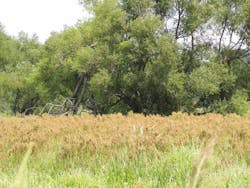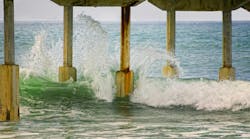Whether it is in urban or rural areas, our society often treats water as a waste product.
The goal is often the same no matter where we live: to convey water away as quickly and efficiently as possible. This is the case for both urban stormwater sewer systems and agricultural ditch and tile systems.
These systems are indeed efficient but can disrupt the historical hydrological cycles and hydrographs of the rivers, streams, and wetlands to which they are connected, and can produce a number of negative environmental impacts.
It does not have to be this way. Innovative solutions, often referred to as “green infrastructure” that use native plants, can retain healthy supplies of clean, usable water for our ecosystems and our communities.
Green infrastructure works with natural processes of water cycling rather than against them. These are not one-size-fits-all engineering approach. They are a highly-designed suite of solutions that consider local geography, soils, and ecosystems to help channel water away from where we do not want it—in our roads and basements—to where we do want it—into the ground, where it belongs.
Native plants, like those we produce at the Stantec Native Plant Nursery in northern Indiana, have an enormous role to play in many aspects of green infrastructure implementation. Native plants can help manage stormwater where it falls and reduce erosion with bioengineered products. Native plants can also treat stormwater and reduce agricultural chemicals through “nutrient farming” and restoring wetlands and adjacent native ecosystems.
Native solutions: rain gardens and bioswales
Rather than slowly percolating into the ground, water is channeled in urban and agricultural landscapes to quickly flow into our rivers and streams. In the lower reaches of a watershed, this can mean increased flooding.
The problem? Impermeable surfaces. In a typical residential setting, the percentage of area covered with impermeable surfaces can be as high as 50%. In dense urban areas it is over 90%. These impermeable surfaces can be roads, sidewalks, driveways but also parking lots and roofs.
There are several “green” solutions available to replace impermeable surfaces, thus reducing the “flashiness” of the flow of surface waters.
In the urban landscape, where much of the ground surface is covered with pavement or asphalt, one solution is a combination of permeable pavement and rain gardens. Permeable pavers are self-explanatory. They are made with durable paving materials for roads, walkways, but allow for the infiltration of water through the material and into the underlying soil.
When precipitation exceeds the amount of water able to infiltrate through these permeable surfaces, water can be directed toward rain gardens and bioswales. Here, the water is retained and can slowly infiltrate within depressions planted with native vegetation.
The Stantec Native Plant Nursery catalog lists plant material for countless rain garden and bioswale projects. Native plants’ roots help to facilitate water infiltration and filter pollutants from stormwater, in addition to providing beauty and habitat for plants and animals. Stantec has created a “Stormwater” seed mix that is formulated to include species that tolerate the highly fluctuating water levels, and poor water quality associated with urban stormwater. The Swale seed mix contains species suited to filtering pollutants from urban stormwater and facilitating infiltration of standing water.
It is important to note that Stormwater or Swale mixes need to match the soil types and sunlight availability for your specific project. We can help contractors find the perfect combinations for their unique settings.
Erosion solutions: bioengineering with plants
One of the challenges in managing stormwater is controlling erosion and stabilizing adjacent banks, shores and slopes. We can use bioengineering materials such as coir logs, rock socks and a Stantec product called RootCarpet, at sites where installation of plant material alone cannot achieve the desired results.
Vegetated coir logs are biodegradable coconut coir pith logs tightly packed in tubular netting. They are highly effective to reduce water velocity at the base of slopes, shorelines, and streambanks. They are used for controlling dry slope erosion and establishing wetland edges and stream channel banks. Coir logs are available either vegetated or unvegetated, in a variety of sizes. They are grown on a contract basis. As the native species establish their root systems, the coir logs biodegrade over several years, allowing a native shoreline to develop.
When establishing native deep-water, submerged plants is a challenge, we can use rock socks to solve the problem of strong currents and fluctuating water levels, which make it difficult for plants to root. Stantec creates its rock socks by using a mesh containment system filled with gravel. Then, native plants are selected and planted in the socks to match the project objectives. The plants are grown out at our nursery until they have fully rooted within the bag. The weight of these bags allows them to sink to the bottom where the developed root systems can easily establish.
Finally, RootCarpet™ consists of thick sections of pre-vegetated coir fiber enclosed in a woven coir blanket that helps keep roots together and soil in place until plant establishment. Because the developed roots actively seek the soil, RootCarpet™ facilitates quick establishment across relatively large areas. It is especially good for wetlands and areas with moving water, and it is effective in controlling weeds.
Agricultural solutions: nutrient farming and wetland restoration
Fertilizer chemical runoff – including nitrogen and phosphorus – can be a significant problem in rural areas, and these chemicals are at the root of so-called “dead zones” further down our waterways. Fertilizer use has been steadily increasing over the past 50 years, both in the United States and around the world. Heavier nutrient loads are responsible for dangerous algal blooms and general water eutrophication, which can have dramatic effects on aquatic ecosystems.
Programs, such as the USDA’s Conservation Reserve Program (CRP), encourage farmers and rural landowners to set aside portions of their land as natural areas, in return for rental payments. These natural areas, especially when buffering fields from waterways, help to sequester many of the nutrients coming off ag fields.
Several potential opportunities exist to remediate agricultural runoff before it reaches our watersheds. One is known as “nutrient farming,” and is being propounded by organizations such as the Wetlands Initiative in Chicago.
Nutrient farming proponents hope to develop nutrient markets that encourage landowners to restore wetlands and buffer zones on their properties. The incentive to do so would come in the form of credits generated from these restorations, which could be sold to municipalities, industrial facilities, or other sources of significant nutrient pollution.
Pilot markets are already being tested—such as the Ohio River Basin Trading Project, and in the Chesapeake Bay watershed.
The Wetlands Institute indicates that large-scale wetland restorations, when placed at strategic points in a watershed, can filter and sequester a sizable portion of nutrients and other pollutants entering the watershed.
The Stantec Native Plant Nursery has often provided native plants and seeds for the Wetland Initiatives’ restoration projects, as well as countless other wetland restoration projects around the Midwest.
Pulling it all together
Over the years, we have gained a great deal of experience over the years working with clients, government agencies, landscape architects, and spec writers in understanding how native plants can be incorporated into urban and rural water management strategies. Each method to absorb or slow water, reduce erosion, or absorb and reduce chemicals works in concert with entire stormwater project.
At the Stantec Native Plant Nursery, we help clients find that green infrastructure that is an effective, elegant way to conserve water, improve water quality and ecosystem health, and create beautiful spaces.
Considering the damage that “collect, convey, discharge” has done over the past century, it’s clear that “conserve, improve, and create” using green infrastructure and native plants is the way of the present and the future.
Mark O’Brien is the business center practice leader for the Stantec Nursery. O'Brien can be reached at [email protected].






